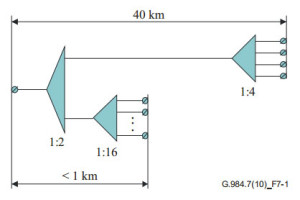This section describe physical layer requirement for FTTH GPON network in three perspective, 1, Spectral Width,2. Attenuation Range, 3. ODN topology, etc.
1 Spectral width
[ITU-T G.984.2] defines certain PMD specifications for the OLT and ONU. For a GPON system operating at 2488 Mbps downstream rate and 1244 Mbps upstream rate, the 20 dB spectral width was originally specified as 1 nm. In order to serve ONUs deployed 0-40 km, 20-60 km or at distances in between with a 40km differential distance from the OLT, the OLT laser 20 dB spectral width needs to be less than or equal to 0.6nm.
2 Attenuation range
An EDR GPON system shall employ the optical components and maintain the optical power levels consistent with one of the standard attenuation range classes: Class B+, Class C, and Class C+. It shall support the maximum fibre distance and the maximum differential fibre distance as specified in the following table.
Table 1 – Physical medium dependant layer parameters of ODN
3 ODN topology
The ODN shall be based on ITU-T G.652 fibre and shall possess the topology, including the location and degree of the power splitter and possible use of passive optical attenuators, to ensure that the minimum loss requirement is met for each ONU.
An ODN accommodating the differential fibre reach approaching 40 km may employ an unbalanced cascade of splitters, where the shortest fibre branches experience the highest degree of split. An example of a Class B+ ODN supporting 13-28 dB attenuation range with maximum physical reach of 40 km and differential fibre reach of 40 km is shown in Figure 2.1. In this example, the ONUs with shorter fibre distance experiences the higher degree of split than the remote ONUs. Specifically, assuming, in the first approximation, 3.5 dB attenuation per binary split and 0.4 dB per kilometre of fibre, one can obtain for the group of near ONUs the total attenuation of 17.5 dB and for the group of remote ONUs the total attenuation of 26.5 dB, both values being within the allowed window for the class.
Other topologies may be possible, provided the ODN meets the specifications given in [ITU-T G.984.2].

